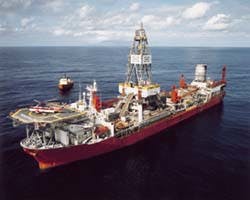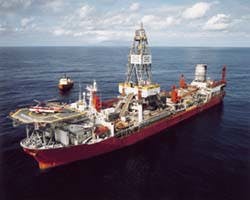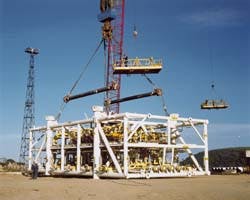SUBSEA DEVELOPMENT Amerada's Hudson turns corner on UK subsea cost-efficiency
Revenue from early production floater will fund subsea development of remaining field
Steve Sasanow
Contributing Editor
Phase 1 of the Hudson development in the North Sea would use production from the Petrojarl 1 test vessel to fund Phase 2 of the project. Production will be offloaded to a shuttle tanker.
In the dozen years or so since Shell and Exxon installed the underwater manifold centre (UMC) in the UK sector of the North Sea, subsea production has meant something exciting and exotic to the offshore industry.
Offshore workers used to make jokes about subsea engineers, as if they were mad scientists who should be allowed out of their locked offices only once every few years lest they infect ordinary engineers with wild ideas at putting perfectly good equipment on the seabottom to get wet and covered in seabed detritus.
And so subsea production grew in importance, complexity, and unintentionally, cost. The Norwegians, in particular, embraced subsea with open arms and open wallets. Vast amounts of money were spent on grandiose concepts. seemingly with the object of re-inventing the wheel as well as re-designing every nut, bolt, seal and valve. Every project in Norway that included subsea production was treated like a research end development program. The subsea fraternity became known as the big spenders of the offshore world.
Then came the realization, in the last few years, that the era of the low-value barrel of oil was going to be the rule, not the exception. Standardization became an important buzzword and it was feared that the accountants would take over from the engineers. Some gloom and doom merchants even suggested that there might be a stifling of innovation and technological developments. There were long faces at gatherings of subsea specialists, as if the cost-cutting initiatives, such as CRINE (UK) and NORSOK (Norway), meant the end of en era.
Turning point
So, should subsea folk be celebrating or bemoaning Amerada Hess' success on the Hudson UK 211/24a subsea development, nearly the most northerly field in the UK sector of the North Sea?
The field's claim to fame is not innovation, but economics. Amerada Hess brought the field into production 30% under budget and two months ahead of schedule. There are no boasts about new metal-to-metal seals, a radical choke valve, or a diverless flowline connector.
There was nothing new about the field - except the approach. There was no talk about net present values or internal rates of return. The two-phase development plan, according to project manager Martin Fielding, was designed to meet certain business driven objectives.
A volume of 17 million bbl plus of oil was to be produced during the first phase when the production test ship Petrojarl 1 pumped crude from two subsea wells. The income from this production would be used to fund the second full subsea phase with five or six producers and two water injectors tied into a manifold and then back to the Tern platform 11 km away.
This was definitely the most cost effective way to develop this field. If it was not, Shell UK Expro would have had something to say about it. Shell, unusually, sat on both sides of the fence. It is an partner on Hudson, but also the operator of Tern.
In its first role, Shell wanted the lowest capital expenditure (CAPEX) to maximize the return on investment. In the second role, Shell wanted to make the most out of the processing and transportation tariff it would charge the Hudson group. Shell couldn't make the tariff too high or Amerada might have suggested to the Hudson partners to go for a full floater development. Shell watched the balancing act. Amerada must have pegged it just right.
Phase 2 of the Hudson development involves deployment of a subsea manifold that will link six producing wells and two injection wells to the nearby Tern platform.
Under budget
How did Amerada bring in a project at £134 million, when this original budget was over £190 million. The operator combined some of the principles of the CRINE cost reduction initiative with an innovative contracting strategy and a bit of good fortune.
CRINE (cost reduction in the new era), the brainchild of Amerada's Rex Gaisford, was launched in the summer of 1992. The first meeting of the operator group took place just weeks before the Hudson project kicked off. Hudson is believed to be the first project conducted under the CRINE banner.
What did this mean, though? It meant functional specifications for all pieces of equipment. There could be no gold plating. Everything had to be off-the-shelf. It meant a small operator project team that did not look over the shoulder of the contractors, but left them to do what they were supposed to be doing. It meant finding the least expensive way of carrying out the project, and not accepting what appeared to be the least expensive route.
For such a small project, it might have seemed obvious to drop the whole package in the lap of one contractor, but Amerada did not think so. Amerada had all the contractors bid the three EPIC packages - the manifold, the pipeline system, the umbilical, and the tie-in work - individually and all together. The firm then created a matrix and looked at the costs. Even when several of the contractors asked to form an alliance with the operator, the price did not come down.
So, each of the contracts went to a different contractor - Rockwater, Stena Offshore, and Stolt Comex Seaway, respectively. It is not often that the three large underwater contractors all work on such a small project.
When one looks at the numbers that Amerada has presented for the project, they are quite impressive. The capital expenditures per bbl are £1.55. The operating expenditure per bbl is £3.97, including the tariff. Add some for abandonment, and the total comes to £5.75, or $8.63/bbl. Amerada reckons this is one of the lowest cost subsea projects to date.
Low cost, low tech
But, is this low cost, almost low tech, off-the-shelf approach good for subsea? What about technical innovation? What about engineering? Of course, it's good. Every successful project increases the confidence level in subsea production. Every project that comes in under budget suggests that this approach could be undertaken on every development.
One of the keys to this project was that Shell carried out the Tern modifications seemingly without a hitch. It was this part of the work that brought forward the date for first production. Shell has shown that platform modifications don't have to be a disaster. Amerada said this success was significant as there are going to be many more third party tie-ins in the future.
As for the subsea work, not every project is going to be this straightforward, although Fielding did say that Amerada is looking ahead at a standardized manifold concept. There will be innovation and Amerada is already involved. The firm's South Scott satellite development will see the first use of a subsea multiphase meter. Who knows what technologies might get used as Amerada and others expend their activities in the deep, wild waters West of Shetlands.
Amerada has taught the industry a good lesson. Subsea doesn't always have to be exciting. It can be conventional, cost-effective, and executed within a tight schedule. Without doubt, the more Hudson-type successes there are, the more subsea production we will see.
AUTHOR
Steve Sasanow is the editor of Subsea Engineering News and a contributor to Offshore Magazine.Copyright 1995 Offshore. All Rights Reserved.


